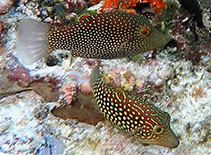| Family: |
Tetraodontidae (Puffers), subfamily: Canthigasterinae |
| Max. size: |
9 cm TL (male/unsexed) |
| Environment: |
reef-associated; marine; depth range 1 - 30 m |
| Distribution: |
Indo-Pacific: East Africa south to Transkei, South Africa (Ref. 4919) and east to the Line, Marquesan, and Oeno islands, north to southern Japan, south to Lord Howe Island. Replaced by Canthigaster jactator in the Hawaiian Islands and Canthigaster punctatissimus in the tropical eastern Pacific (Ref. 37816). Also recorded from Southeast Atlantic. |
| Diagnosis: |
Dorsal spines (total): 0-0; Dorsal soft rays (total): 9-10; Anal spines: 0-0; Anal soft rays: 9-10. Many white spots scattered on body (Ref. 559).
Description: Characterized by brown color with dense covering of pupil-sized blue green to white spots extending onto basal portion of caudal fin; depth of body at origin of anal fin 2.2-2.6 in SL; head length 2.4-2.6 in SL; snout length 1.5-1.6 in head length; bony interorbital width 3.0-3.8 in head length; caudal peduncle depth 1.8-2.3 in head length; slightly rounded caudal fin (Ref. 90102). |
| Biology: |
Occurs in clear lagoon and seaward reefs, Ref. 48637. Found with sponges at various depths (Ref. 48637). Prefers sheltered areas in the form of holes in dead and living corals. Solitary or paired. Feeds on sponges, polychaetes, filamentous algae and on smaller quantities of tunicates, crustaceans, echinoderms and corals. |
| IUCN Red List Status: |
Least Concern (LC); Date assessed: 08 June 2011 Ref. (130435)
|
| Threat to humans: |
harmless |
Source and more info: www.fishbase.org. For personal, classroom, and other internal use only. Not for publication.

